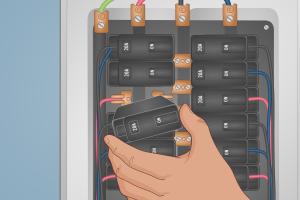Mastering the Art of Starting a Gas Furnace: A Comprehensive Guide

-
Quick Links:
- 1. Understanding Gas Furnaces
- 2. Safety First: Precautions Before Starting Your Gas Furnace
- 3. Step-by-Step Guide to Starting Your Gas Furnace
- 4. Common Issues and Troubleshooting
- 5. When to Call a Professional
- 6. FAQs
1. Understanding Gas Furnaces
Gas furnaces are a popular choice for heating homes due to their efficiency and reliability. They work by burning natural gas or propane to produce heat, which is then distributed through ductwork to warm your living spaces. Understanding the components and operation of a gas furnace is crucial for effective use and maintenance.
1.1 Components of a Gas Furnace
- Burner: The component where gas is mixed with air and ignited.
- Heat Exchanger: Transfers heat to the air circulating through the furnace.
- Blower: Moves the heated air through the ductwork.
- Thermostat: Regulates the temperature setting for your home.
- Flue Pipe: Expels exhaust gases outside.
1.2 Types of Gas Furnaces
There are two main types of gas furnaces: single-stage and two-stage. Single-stage furnaces operate at full capacity, while two-stage models can adjust their output to save energy and maintain comfort.
2. Safety First: Precautions Before Starting Your Gas Furnace
Before attempting to start your gas furnace, it’s important to follow safety precautions to prevent accidents and ensure proper operation:
- Ensure there are no gas leaks: Use soapy water on gas lines and connections to check for bubbles.
- Clear the area around the furnace: Remove any flammable materials or debris.
- Check the carbon monoxide detector: Ensure it’s functioning properly.
- Wear protective gear: Gloves and safety glasses can protect you during maintenance.
3. Step-by-Step Guide to Starting Your Gas Furnace
Now that you’ve ensured everything is safe, follow these steps to start your gas furnace:
Step 1: Set the Thermostat
Adjust your thermostat to the desired temperature. This signals the furnace to start heating.
Step 2: Check the Gas Valve
Ensure the gas valve is open. The handle should be parallel to the gas line.
Step 3: Turn on the Power
Locate the power switch near the furnace and turn it on. The blower fan should start running.
Step 4: Ignite the Pilot Light (if applicable)
If your furnace has a pilot light, follow these steps:
- Locate the pilot light access door.
- Turn the gas control knob to “Pilot.”
- Press the igniter button or use a long lighter to ignite the pilot light.
Step 5: Set the Gas Control to “On”
Once the pilot light is lit, turn the gas control knob to “On.” This allows gas to flow to the burners.
Step 6: Check for Heat
After a few moments, you should feel warm air blowing from the vents. If not, refer to the troubleshooting section.
4. Common Issues and Troubleshooting
Even with proper starting procedures, issues may arise. Here are common problems and their solutions:
4.1 No Heat
- Check the thermostat settings.
- Inspect the gas supply and valve.
- Ensure the pilot light is lit.
4.2 Strange Noises
Rattling or banging noises may indicate loose parts or airflow problems. Inspect and tighten any loose components.
5. When to Call a Professional
If you encounter persistent problems or feel uncomfortable performing maintenance, it’s best to call a qualified HVAC technician. They can perform a thorough inspection and ensure your furnace operates safely and efficiently.
FAQs
-
What should I do if my gas furnace won't start?
Check the thermostat, gas supply, and pilot light. If the problem persists, consult a professional.
-
How often should I service my gas furnace?
It’s recommended to service your furnace annually to ensure optimal performance and safety.
-
What are the signs of a gas leak?
Watch for a rotten egg smell, hissing sounds, or dead vegetation near gas lines.
-
Can I light my furnace’s pilot without a professional?
Yes, as long as safety precautions are followed and you feel comfortable doing so. If unsure, seek professional help.
-
Is it normal for my furnace to cycle on and off frequently?
This could indicate a problem; it’s best to have it checked by an HVAC technician.
-
How can I improve my gas furnace’s efficiency?
Regular maintenance, sealing ductwork, and using a programmable thermostat can improve efficiency.
-
What is the average lifespan of a gas furnace?
Typically, a gas furnace lasts between 15 to 30 years, depending on maintenance and usage.
-
Are there any safety features in modern gas furnaces?
Yes, modern furnaces have safety features like flame sensors, limit switches, and carbon monoxide detectors.
-
Can I convert my gas furnace to electric?
Yes, but it requires a complete overhaul of the system. Consult a professional for options.
-
What should I do if there’s a power outage?
Most gas furnaces require electricity to operate the blower and ignition system. Consider backup heating options.
Random Reads
- How to use chatroulette
- Learn to use tor on iphone
- Keeping music playing roblox
- How to keep computer awake without touching mouse
- Quickly zoom out on mac
- Mastering cutting rigid foam insulation
- Power down ipad
- How to recall email in gmail
- How to reboot cable box
- How to share location android to iphone